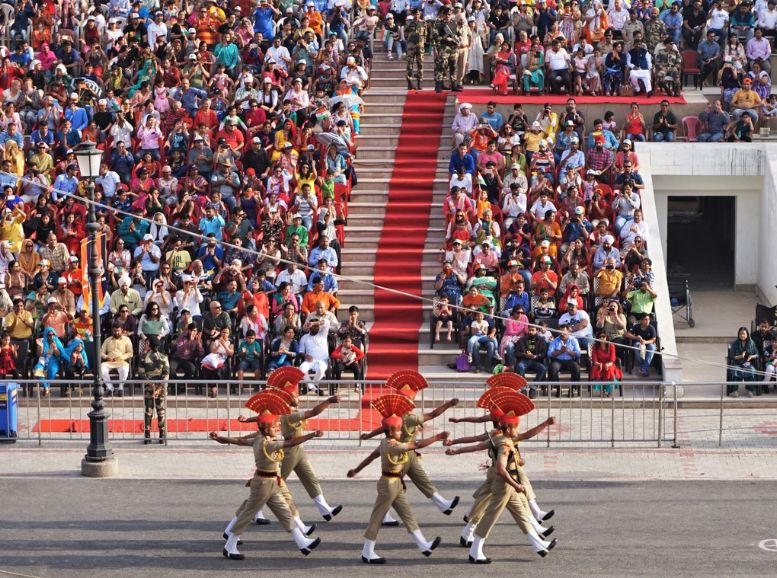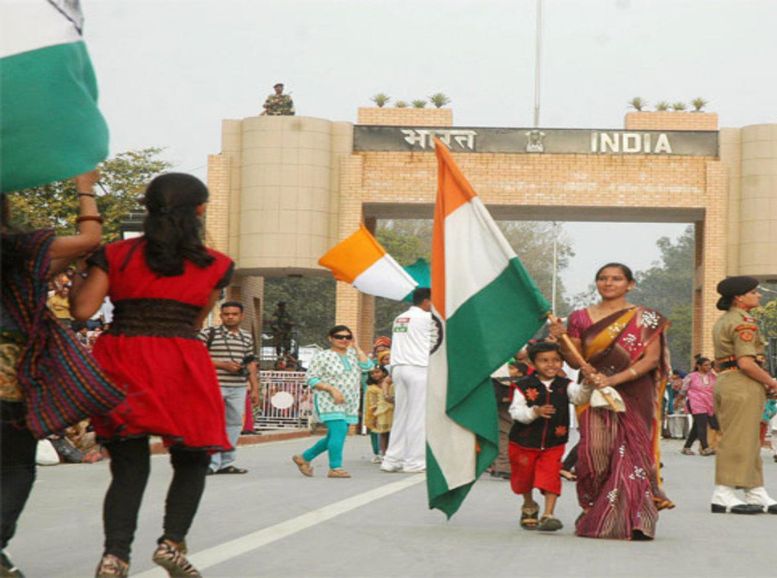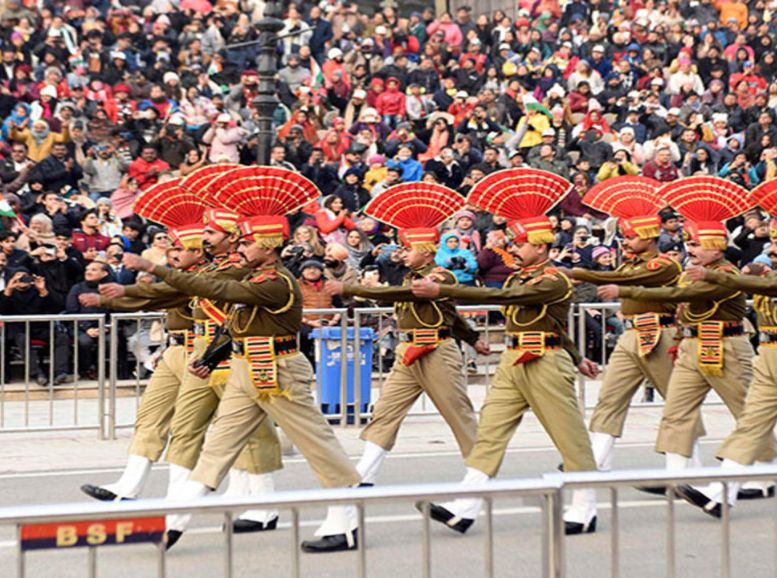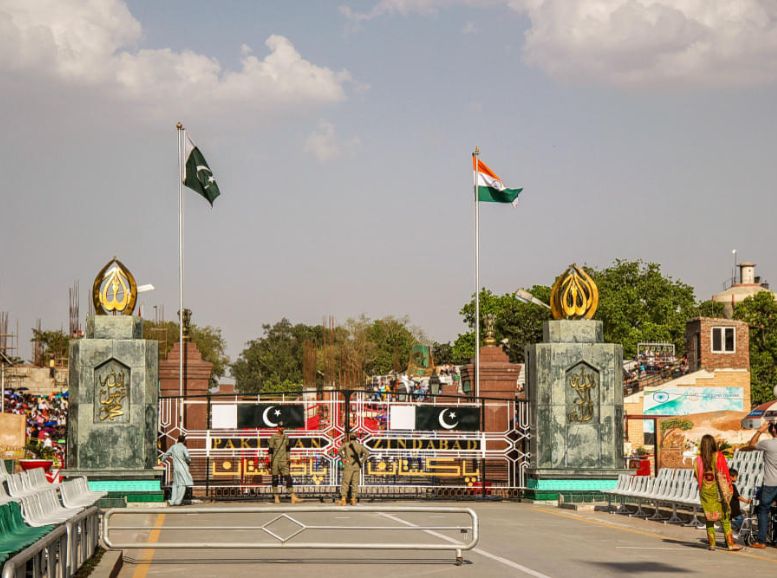Punjab’s heart beats with rich cultural heritage and bustling streets. Nestled amidst this vibrancy lies the Wagah Border, a place of deep significance. This India-Pakistan border crossing, a short distance from the Golden Temple, holds a special place in the hearts of all who visit.
As the sun dips below the horizon, the Wagah Border ignites with a spectacle unlike any other – the Wagah Border Ceremony. This blog delves into the allure and importance of this Amritsar landmark.
The Wagah Border transcends its geopolitical significance. It stands as a beacon of hope, unity, and cultural exchange. Here, history echoes with the rhythmic steps of border guards, and patriotism fills the air.
How to reach:
Road Trip: For convenience, consider a taxi or local bus. The 28-kilometer journey takes roughly 45 minutes to an hour, depending on traffic.
Train Travel: Take a train to Attari, the closest station to the border. From there, grab a taxi or auto-rickshaw for the final leg. The train ride from Amritsar to Attari lasts 30-45 minutes, with the station just 3 kilometers from the border.
Organized Tours: Let a travel agency handle the logistics. Many Amritsar agencies offer tours to the Wagah Border, including transportation and guided explanations of the ceremony’s history and significance.
Hitting the Road Yourself: If you have your own vehicle or a rental, follow the well-marked signs leading to the border from Amritsar. Be aware of potential security checks and restrictions near the border area. Ensure you have any necessary documents or permits.
Ride-Sharing Apps: Utilize ride-sharing apps like Uber or Ola to book a comfortable cab ride directly to the Border. Check ride availability and estimated fares before booking.
Best time to visit:
- Pleasant Outdoors: Escape the summer’s scorching heat. Winter brings milder temperatures, making outdoor activities like attending the Wagah Border Ceremony much more enjoyable.
- Ceremony Comfort: The open-air stadium setting of the Wagah Border Ceremony is more comfortable in the cooler winter months.
- Fewer Crowds: Escape the peak tourist season rush. Winter often sees fewer visitors, leading to shorter queues and less congestion at the border.
- Crystal Clear Views: Winter skies tend to be clearer, offering unobstructed views of the ceremony’s flag-lowering and other activities by the border guards.
- Festive Flair: Winter coincides with vibrant festivals like Diwali and Christmas, adding a special celebratory vibe to your Amritsar visit.
Must see things:
Unveiling the Wagah Border Ceremony:

At the heart of the Border experience lies the Wagah Border Ceremony, a spectacle of military precision and national pride. As the gates swing open and the crowd thrums with excitement, soldiers from both nations march in perfect sync, their high-energy maneuvers a testament to their discipline. The beating of drums, the blare of bugles, and the rhythmic chants of “Jai Hind” and “Pakistan Zindabad” rise in a crescendo, echoing across the border and creating an electrifying atmosphere that captivates all who witness it. Amidst the pomp and pageantry, the lowering of the flags marks the day’s end. Yet, the enduring spirit of camaraderie and respect lingers on, a testament to the complex relationship between these two nations.
Beyond Borders: Exploring the Cultural Tapestry:

The Ceremony might steal the spotlight, but beyond the gates lies a vibrant tapestry waiting to be explored. Bustling market stalls overflow with colorful trinkets, traditional Punjabi attire, and the aroma of tempting street food. Here, you can delve into the heart of Punjabi culture. Savor the explosion of flavors in spicy chaat or piping hot jalebis. Browse handcrafted treasures and souvenirs, each one a potential memento to carry a piece of this place with you. As the sun dips lower and the crowds begin to disperse, the Wagah Border transforms. It becomes a stage for cultural exchange and camaraderie, where strangers strike up conversations and lasting memories are made.
Pared at wahag border:

A daily spectacle unfolds at the Wagah Border, where meticulously choreographed retreat ceremonies transform the frontier into a vibrant stage. Synchronized military drills by Indian and Pakistani forces ignite patriotic fervor, fuelled by cheers and nationalistic songs from a global audience. This captivating display embodies the complexities of the India-Pakistan relationship. While camaraderie and shared heritage simmer beneath the surface, tensions rise with each synchronized step, making the Wagah Border ceremony a testament to the enduring ties and occasional friction that define their bond.
Local experiences:
- Connect with Locals: Strike up conversations with vendors and residents. Learn about their lives and gain cultural insights.
- A Culinary Adventure: Embark on a flavor journey! Sample local delicacies like spicy chaat or crispy pakoras from the enticing food stalls.
- Treasure Hunt: Explore the colorful stalls overflowing with traditional handicrafts, textiles, and souvenirs. Find unique embroidered textiles, handcrafted jewelry, or a special memento of your visit.
- Cultural Delights: Keep an eye out for cultural performances like Bhangra or Giddha dances, adding to the festive atmosphere.
- Local Customs: Observe rituals and customs practiced by locals. You might even participate in ceremonies celebrating regional unity and heritage.
- Village Escape: Venture beyond the border to explore nearby villages. Immerse yourself in rural life, with lush fields, quaint homes, and warm hospitality.
- Craft Your Own Art: Learn traditional crafts like Phulkari embroidery or Punjabi folk art through workshops or classes. Local artisans are happy to share their skills.
- Live Like a Local: Consider a homestay with a local family near Border. Experience daily life, participate in family activities, and savor authentic Punjabi cuisine.
Planning Your Visit:
If you’re considering a visit to the Border, there are several key points to consider to ensure you maximize your experience. The border ceremony occurs each evening prior to sunset, so it’s recommended to arrive well in advance to secure optimal viewing positions. Remember to carry valid identification and adhere to the directives provided by security personnel throughout your time at the border. Additionally, it’s essential to dress in a manner that is modest and respectful, recognizing the solemnity and reverence associated with the Wagah Border for many individuals.
conclusion
The Wagah Border, renowned for its vibrant energy and profound symbolism, presents a plethora of local experiences that are both enriching and memorable. From engaging with the welcoming locals to relishing the diverse flavors of Punjab’s culinary delights, each moment spent at the Wagah Border offers an immersion into the rich tapestry of local culture and traditions. As the sun sets and the Wagah Border Ceremony concludes, visitors depart with hearts brimming with admiration for the unity and resilience displayed at this historic frontier. Whether observing captivating cultural performances, perusing for distinctive souvenirs, or simply basking in the atmosphere of camaraderie, the Wagah Border etches an enduring impression on all who venture there. For those contemplating a visit, consider enhancing your experience by arranging a guided tour through Xplro.com, where seasoned guides will navigate you through the intricacies of this cultural gem. Embrace the awaiting local experiences, engage with the vibrant community, relish the flavors of Punjab, and cherish the moments of connection and camaraderie. At the Wagah Border, amid the fluttering flags and resounding chants, one uncovers the genuine essence of Punjab’s hospitality, warmth, and timeless traditions.
FAQ
- What is the Wagah Border?
- The Border serves as a demarcation line between India and Pakistan, located near Amritsar in the Indian state of Punjab.
- Where is the Wagah Border located?
- Situated approximately 28 kilometers from Amritsar, Punjab, India, the Wagah Border holds strategic importance as the primary road crossing between India and Pakistan.
- What is the significance of the Wagah Border?
- The Border symbolizes the partition of India and Pakistan in 1947 and serves as a focal point for diplomatic relations between the two nations. Additionally, it hosts the renowned Wagah Border Ceremony, showcasing the closing of the border each evening with a display of military pageantry and patriotism.
- What is the Wagah Border Ceremony?
- The Wagah Border Ceremony is a daily military ritual conducted by the border security forces of India and Pakistan. It features elaborate drills, flag lowering, and spirited displays of nationalism, captivating spectators on both sides of the border.
- What time does the Wagah Border Ceremony take place?
- The Wagah Border Ceremony typically commences every evening before sunset, usually around 5:30 PM to 6:00 PM, adhering to seasonal variations.
- How long does the Wagah Border Ceremony last?
- The Wagah Border Ceremony generally spans 30 to 45 minutes, showcasing synchronized drills and culminating in the lowering of flags by both nations.
- Is there an entry fee to visit the Wagah Border?
- No, there is no admission fee required to witness the Wagah Border Ceremony, making it accessible to all visitors.
- Can I take photographs at the Wagah Border?
- Visitors are permitted to capture photographs and videos during the Wagah Border Ceremony, providing an opportunity to memorialize this iconic spectacle.
- Are there any restrictions or guidelines for visitors at the Wagah Border?
- It is advisable for visitors to carry valid identification, arrive early to secure optimal viewing positions, and adhere to instructions provided by security personnel to ensure a safe and respectful experience.
- What should I wear when visiting the Wagah Border?
- Visitors are encouraged to dress modestly and respectfully, avoiding attire that may be deemed inappropriate for the solemnity of the occasion.
- How do I reach the Wagah Border from Amritsar?
- The Wagah Border is accessible from Amritsar by various modes of transportation, including taxis, buses, or organized tours, facilitating convenient travel for visitors.
- Are there any accommodations near the Wagah Border?
- While accommodations near the Border are limited, visitors often choose to stay in hotels located in Amritsar, which offers a wider range of lodging options.
- Can I visit the Wagah Border on weekends and holidays?
- Yes, the Wagah Border Ceremony takes place daily, including weekends and holidays, providing visitors with the opportunity to experience this iconic event throughout the week.
- Are there any nearby attractions or activities to explore besides the Wagah Border Ceremony?
- Nearby attractions include the revered Golden Temple, historic Jallianwala Bagh, and opportunities for indulging in local cuisine and shopping for traditional handicrafts in Amritsar.
- Is it safe to visit the Wagah Border?
- Yes, visiting the Border is generally safe, with security measures in place to ensure the well-being of visitors. However, it is recommended to exercise caution and comply with security guidelines during your visit.






